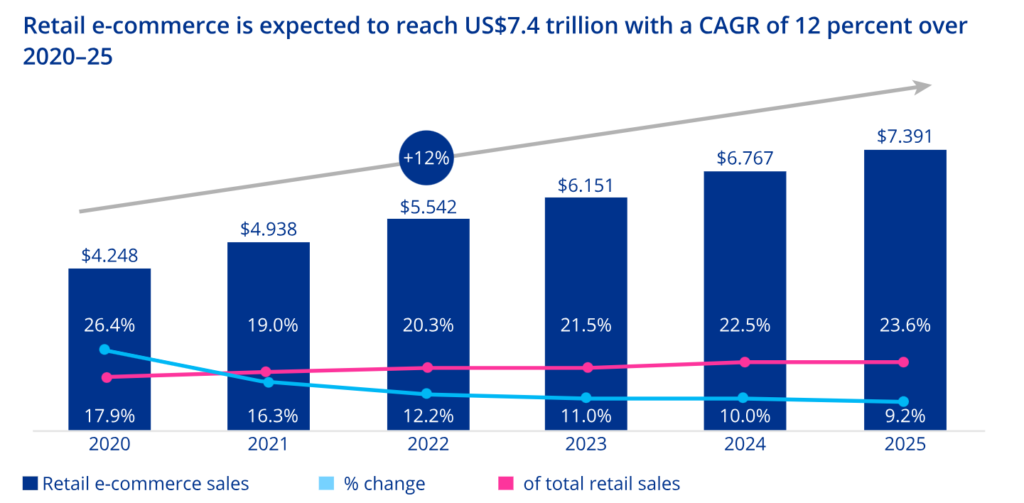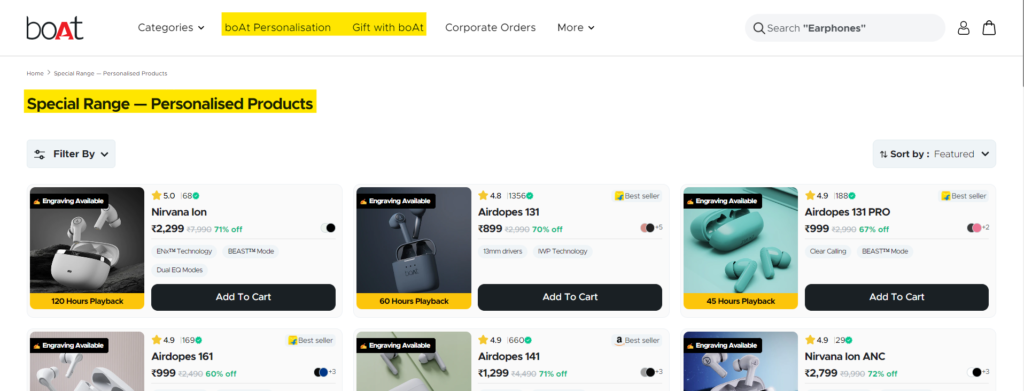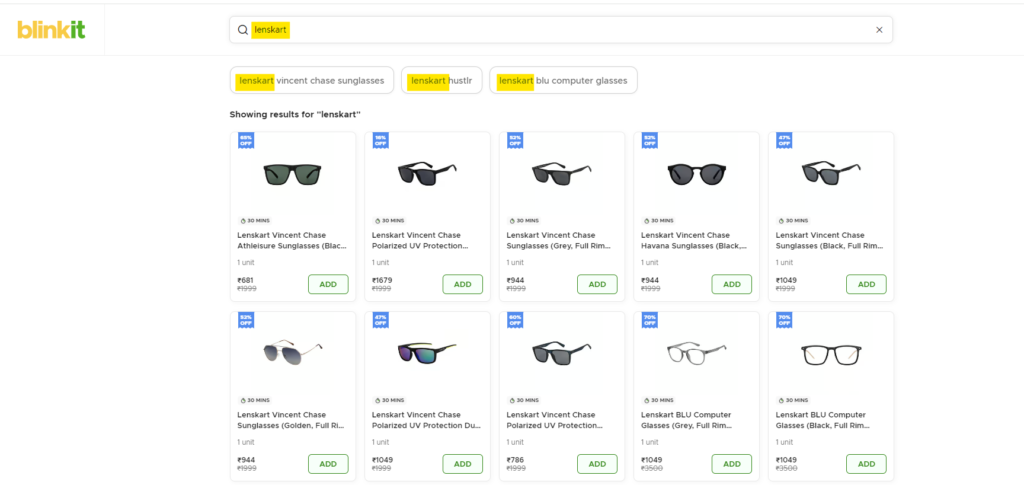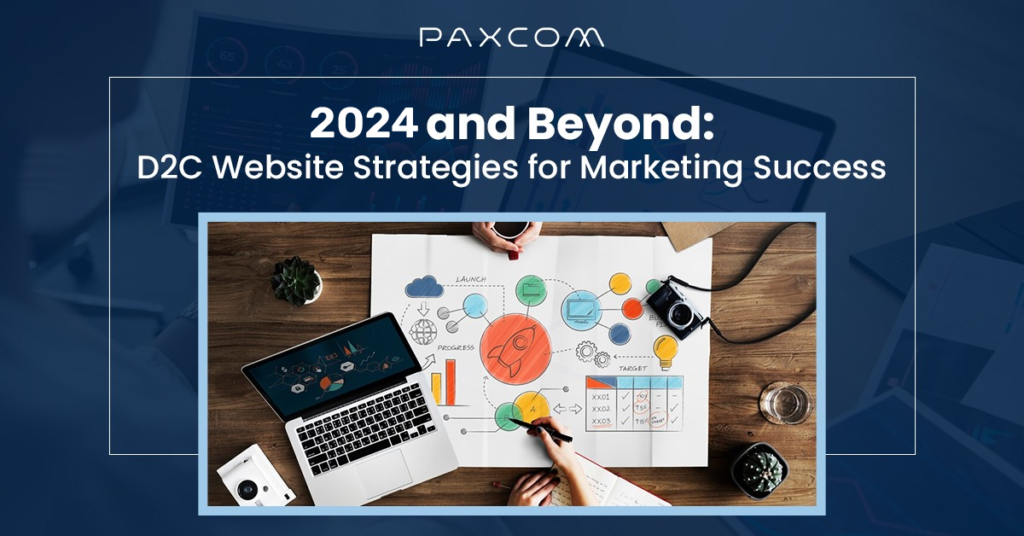In a rapidly evolving e-commerce landscape, direct-to-consumer (D2C) trends have emerged as a game-changer for businesses of all sizes. This guide explores the transformative potential of a D2C website design in 2023, providing marketers with key insights, strategies, and an optimized approach for success.
D2C business success demands a comprehensive framework that includes acquisition, conversion, and retention in addition to e-commerce. While conversion strategies concentrate on producing interesting content and a smooth interaction with e-commerce platforms, acquisition tactics include social listening and client data platform management. Retention strategies, such as first-rate customer care and loyalty plans, create enduring bonds with clients and encourage return business. Organizations may create a well-rounded D2C e commerce strategy that opens doors for expansion and success in the digital sphere by putting these components into practice.
The fundamentals influencing conversion and cart size for most brands with successful e-commerce businesses have stayed the same for ten years. Creating incredibly dynamic landing pages for users is an innovative application of AI. Gaining in-depth familiarity with your target demographic is the first step in achieving high-label precision through the use of predictive analytics powered by artificial intelligence (AI) and machine learning.
In 2024, data will reign supreme. Decisions for direct-to-consumer brands should be based on consumer data and sophisticated analytics.

Table of Contents
Advantages of Direct-to-Customer websites
Consider a not-too-distant future corporate scenario in which traditional distribution channels no longer set the rules. It’s a world where the complicated dance between manufacturers, wholesalers, retailers, and customers has changed radically, rewriting the story of how businesses interact with their clients. This is the era of the direct-to-consumer (D2C) model, in which a paradigm shift in marketing dynamics has opened up limitless possibilities.
With the ongoing digital transformation of the globe, an increasing number of organizations are opting to engage in direct online sales to customers using the direct-to-consumer (D2C) model.
D2C Model
Direct-to-consumer (D2C) is a product manufactured in-house by a business organization and distributed through its own channels.
Picture a journey where you can skip the usual steps and reach your customers directly. In today’s digital world, marketing becomes your secret weapon in this branding for D2C setup. But why is having this advantage such a big deal, you ask? Well, that’s what we’re here to explore.
The shift to D2C: meeting consumer expectations
A notable evolution has occurred in India’s retail sector, characterized by the proliferation of direct-to-consumer (D2C) businesses. D2C ecommerce has reshaped the relationship between companies and consumers over the past two decades, creating a tremendous opportunity for domestic brands to emerge.
Modern consumers demand a streamlined purchasing process, convenient shopping experiences, and a direct connection with brands. Many buyers visit a brand’s website and third-party channels before purchasing. Recognizing these preferences, brands have embraced an omnichannel approach, gradually sidelining intermediaries. As a result, numerous brands now sell products directly from their own websites, following a direct-to-consumer (D2C) selling model.
Consumer expectations in regards to the rise of D2C websites:
A brand’s strategy can be fine-tuned for optimal impact by predicting consumer behavior. As D2C websites rise to prominence, consumer expectations are evolving alongside them. Today’s shoppers crave more than just a transaction. They seek a seamless, personalized experience that builds brand connection and caters to their needs.
Understanding D2C website sales
D2C stands for direct-to-consumer, a revolutionary concept where manufacturers and brands eliminate intermediaries to promote and sell their products directly to consumers. This approach has replaced the traditional complex supply chain involving manufacturers, wholesalers, and retailers. Consumers increasingly prefer visiting a brand’s website for product research and purchases.
D2C business sales have no barriers between manufacturers and buyers, fostering open interaction. This enables manufacturers to understand customer expectations better while gaining more control over brand reputation, marketing, sales tactics, and pricing.
For Eg:- In 2021, Jigar Shah and Bollywood actress Deepika Padukone launched the direct-to-consumer (D2C) personal care brand 82°E. Recently, according to a report by the Economic Times, Reliance Retail’s Tira and Deepika Padukone’s 82°E teamed up to enter the offline beauty market. By working with Tira, 82°E is reaching a wider audience by distributing its skincare, body care, and men’s lines in Tira stores in a few markets in North, West, and South India. This alliance intends to democratize access to luxury skincare products for a more varied audience.
Supercharged Engagement with Video:
Dominate user attention by strategically integrating high-quality videos throughout your website. Showcase product features in captivating demonstrations, provide clear instructions with educational films and build trust with authentic customer testimonials. This video trifecta will skyrocket engagement, boost conversions, and improve SEO.
Personalization 2.0: The Data-Driven Customer Journey
Unlock the power of data to craft personalized experiences that resonate with each visitor. Leverage customer information to tailor website content, suggest products that align with individual interests, and craft targeted email marketing campaigns. This data-driven approach fosters deeper customer connections and fuels long-term brand loyalty.
Key Steps for Launching Your D2C Brand
Identify your niche: Conduct extensive market research to identify market gaps and launch a unique segment that addresses specific customer needs. Differentiate your products to draw a more comprehensive customer base.
Select the Right E-Commerce Website Builder: Choose an e-commerce website builder that aligns with your website’s critical functionalities and features. Popular options include BigCommerce, Shopify, Magento, WooCommerce, and Nocommerce.
Choose a Unique Domain Name: Your domain name is your brand’s online identity. Opt for a short, easily recognizable, and keyword-induced domain name.
Create an exceptional user experience: design a user-friendly, mobile-responsive, visually appealing website with a systematic and intuitive user interface. Prioritize product visibility, easy navigation, and smooth payment processes.
Enhance Product Presentation: Showcase products with engaging visuals and detailed information. In product imagery, address customer queries and highlight what differentiates your products.
Establish a Strategic Shipping Policy: Communicate your shipping policy, including estimated delivery times—partner with a reliable shipping service provider known for prompt service.
Thoroughly Test Your Website: Conduct extensive testing to ensure all functionalities work smoothly and your site is mobile-optimized. Pay attention to design consistency and include customer testimonials.
Implement Aggressive Marketing: Create a comprehensive marketing campaign that showcases product previews, promos, discounts, satisfied customer testimonials, and influencer marketing. Utilize SEO, SEM, email marketing, and other digital marketing strategies.
Transparent Privacy and Return Policies: Clearly articulate your privacy and return policies to boost customer confidence. Offer liberal return policies, including free returns and quick refunds.
Robust Customer Support: Your website should have an efficient customer support system with quick issue resolution and a Q&A section. A responsive support team enhances customer satisfaction.
D2C Marketing Strategies for Short- and Long-Term Growth
Balancing short-term results with long-term, sustainable growth is key. D2C marketing offers strategies that cater to both. While some D2C trends/strategies provide quick results, others focus on long-term reliability.
Short-term Marketing Strategies for the D2C Website:
- Content Marketing: Create informative blog posts or guides about your products or industry. This establishes your brand as an authority and attracts organic traffic through search engines (SEO).
- Pay-per-click advertising: utilize PPC platforms like Google Ads to target specific keywords and demographics with search ads or display them across relevant websites. This generates targeted traffic quickly.
- Social Media Engagement: Run contests, giveaways, or polls on your social media platforms. This increases engagement and brand awareness while generating leads.
- Limited-Time Discounts: Offer flash sales, discount codes, or free shipping promotions to incentivize immediate purchases.
- Referral Programs: Encourage customer acquisition by offering referral discounts to both existing and new customers.
- Helping new businesses build brand recognition through more excellent impressions.
- Capitalizing on quick sales during holidays, sales, and seasonal events.
- It is generating rapid cash flow.
- Launching new products successfully.
- Supporting a multi-channel strategy.
Long-term marketing strategies for the D2C website:
- Focus on optimizing your website for relevant keywords to improve organic search ranking. This drives free, long-term traffic to your D2C website.
- Increasing site visibility and reach through high-quality content. Develop informative and engaging content that educates and entertains your target audience. This could include blog posts, articles, infographics, videos, etc.
- Improving sales and revenue without relying heavily on expensive ads Consider paid advertising on platforms like Google Ads and social media to target specific demographics and interests. However, prioritize building organic reach for long-term sustainability.
- Engaging e-commerce shoppers at every stage of the buying process. Create content that caters to potential customers at every stage of their buying journey.
- Building lasting brand recognition. Implement a loyalty program to reward repeat customers and incentivize them to return.
- Email Marketing: Build an email list and send targeted email campaigns with valuable content, promotions, and personalized offers.
The Rise of Social Commerce
Social media has become a pivotal channel for D2C e-commerce and marketing. It allows brands to extend their reach, grow visibility, and direct website traffic. Common ad types include photo ads, story ads, video ads, carousel ads, collection ads, messenger ads, and on-platform shops.
The importance of high-quality content
Quality content serves as the cornerstone of D2C website design and marketing. Channels such as search engines, social media, email marketing, and paid ads heavily rely on engaging content. Google’s EAT concept underscores the significance of high-quality content that meets users’ needs. To excel in D2C marketing, prioritize crafting useful, information-rich content, maintain a clear site hierarchy, incorporate relevant SEO keywords, emphasize user experience over search engine rankings, and steer clear of deceptive tactics.
2024: India’s Year of D2C Growth
The Indian D2C market has been on a tear for several years, and experts predict continued growth. According to reports, by 2027, there will be a staggering number of online shoppers in India, indicating a massive potential customer base for D2C brands. D2C marketing and sales will significantly increase artificial intelligence (AI) use. Expect to see more personalization, targeted advertising, and chatbots powered by AI.
Key Trends Shaping D2C Marketing in 2024
Hyper-Personalization: A “one-size-fits-all” approach is no longer effective. Tailoring hyper-personalization to individual tastes, requirements, and visions is the way forward.

Aman Gupta’s brand, Boat, the standout star of Shark Tank, has strategically embraced three foundational marketing tactics to captivate and sustain its customer base: empathizing with consumer needs, fulfilling customer desires, and decoding consumer behavior trends. The brand has forged enduring connections by fostering a familial bond with buyers, solidifying loyalty. The boat has enlisted cricket icons and celebrities as brand advocates to extend its influence and appeal to a broad audience, amplifying its reach across the masses.
Omnichannel Strategies: Cracking offline sales will be critical for D2C e commercebrands. Strong unit economics and profitability will be non-negotiable. Omnichannel experience: In 2024, the omnichannel experience is no longer just a vision—it’s a reality that dazzles. Picture this: you add a product to your cart on your desktop, then effortlessly pick up where you left off on your phone. With a consistent experience across platforms, transitions between digital exploration, in-person purchases, and post-sale assistance are a breeze. Give customers a personalized and hassle-free experience.
Boosting Brand-Customer Relationships: Building emotional connections with customers is vital. Meaningful relationships can make customers loyal, even in a competitive market.
Social Commerce and Performance-Based Marketing: Social media, influencer marketing, and performance-based strategies will continue to gain prominence, offering growth opportunities. Brands are harnessing the power of social media to create engaging shopping experiences, from interactive video shopping to live broadcasts and the innovative try-before-you-buy concept.
For example, Sugar Cosmetics collaborated with a mix of established beauty influencers with large followings (macro-influencers) and up-and-coming beauty enthusiasts (micro-influencers) on social media platforms like Instagram. This strategy allowed them to reach a broad audience while maintaining a relatable and authentic feel.
Qcom, the growing sector Many quick-commerce companies have begun branching out beyond groceries to other products. Sales on quick-commerce sites are skyrocketing in several categories, including health, electronics, toys, and beauty.

In Quick Commerce, online marketplaces such as Zomato, Swiggy, BlinkIt, Amazon Fresh, and Big Basket have revolutionized how food manufacturers may reach a worldwide customer base. These online markets and delivery services have replaced physical storefronts for food enterprises, allowing them to interact with consumers worldwide while showcasing their gourmet products.
For example, Blinkit has now introduced Lenskart items. They stated that the items would be delivered within ten minutes.
Conclusion
The direct-to-consumer business (D2C) model has become increasingly popular as eCommerce continues to dominate the retail industry. With the rising number of online shoppers in India, D2C e commerce brands have the potential to generate significant revenue and establish a loyal customer base. D2C platforms offers several advantages, including greater control over brand image and customer experience and access to valuable customer data. To succeed in the D2C space, brands need to prioritize. As 2024 unfolds as the year of D2C e commerce growth in India, it’s time to seize the opportunities, adopt the right strategies, and partner with experts like Paxcom to ensure your success in direct-to-consumer marketing. Connect with us at info@paxcom.net














